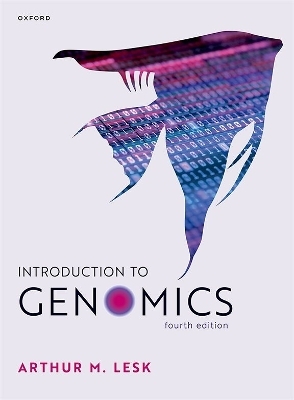
Introduction to Genomics
Seiten
2025
|
4th Revised edition
Oxford University Press (Verlag)
978-0-19-886689-3 (ISBN)
Oxford University Press (Verlag)
978-0-19-886689-3 (ISBN)
- Noch nicht erschienen (ca. März 2025)
- Versandkostenfrei innerhalb Deutschlands
- Auch auf Rechnung
- Verfügbarkeit in der Filiale vor Ort prüfen
- Artikel merken
The most up-to-date and complete textbook for first time genomics students, Introduction to Genomics offers a fascinating insight into how organisms differ or match; how different organisms evolved; how the genome is constructed and how it operates; and what our understanding of genomics means in terms of our future health and wellbeing.
Our genome is the blueprint for our existence: it encodes all the information we need to develop from a single cell into a hugely complicated functional organism. Yet it is more than a static information store: our genome is a dynamic, tightly regulated collection of genes, which switch on and off in many combinations to give the variety of cells from which our bodies are formed. But how do we identify the genes that make up our genome? How do we determine their function? And how do different genes form the regulatory networks that direct the processes of life?
Introduction to Genomics is the most up-to-date and complete textbook for students approaching the subject for the first time. Lesk's engaging writing style brings a narrative to a disparate field of study and offers a fascinating insight into what can be revealed from the study of genomes. The book covers: the similarities and differences between organisms; how different organisms evolved; how the genome is constructed and how it operates; and what our understanding of genomics means in terms of our future health and wellbeing.
Digital formats and resources
The book is available for students and institutions to purchase in a variety of formats, and is supported by online resources:
· The e-book offers a mobile-compatible experience and convenient access along with functionality tools, navigation features, and links that offer extra learning support: www.oxfordtextbooks.co.uk/ebooks
· Online resources, available for registered adopters, include downloadable figures and tables from the book
· E-book and Trove formats are enriched with online resources for students, including extensive and imaginative weblems (web-based problems) for each chapter; hints and answers to end-of-chapter problems and exercises to support self-directed learning; a guided tour of websites and major archival databanks in genomics to springboard further research; Journal Club (links to related research articles on topics covered in the book paired with engaging questions); and rotating figures which allow readers to visualize complex structures.
Our genome is the blueprint for our existence: it encodes all the information we need to develop from a single cell into a hugely complicated functional organism. Yet it is more than a static information store: our genome is a dynamic, tightly regulated collection of genes, which switch on and off in many combinations to give the variety of cells from which our bodies are formed. But how do we identify the genes that make up our genome? How do we determine their function? And how do different genes form the regulatory networks that direct the processes of life?
Introduction to Genomics is the most up-to-date and complete textbook for students approaching the subject for the first time. Lesk's engaging writing style brings a narrative to a disparate field of study and offers a fascinating insight into what can be revealed from the study of genomes. The book covers: the similarities and differences between organisms; how different organisms evolved; how the genome is constructed and how it operates; and what our understanding of genomics means in terms of our future health and wellbeing.
Digital formats and resources
The book is available for students and institutions to purchase in a variety of formats, and is supported by online resources:
· The e-book offers a mobile-compatible experience and convenient access along with functionality tools, navigation features, and links that offer extra learning support: www.oxfordtextbooks.co.uk/ebooks
· Online resources, available for registered adopters, include downloadable figures and tables from the book
· E-book and Trove formats are enriched with online resources for students, including extensive and imaginative weblems (web-based problems) for each chapter; hints and answers to end-of-chapter problems and exercises to support self-directed learning; a guided tour of websites and major archival databanks in genomics to springboard further research; Journal Club (links to related research articles on topics covered in the book paired with engaging questions); and rotating figures which allow readers to visualize complex structures.
Arthur M. Lesk is Professor of Biochemistry and Molecular Biology at The Pennsylvania State University, USA.
| Erscheint lt. Verlag | 31.3.2025 |
|---|---|
| Verlagsort | Oxford |
| Sprache | englisch |
| Maße | 195 x 265 mm |
| Themenwelt | Informatik ► Weitere Themen ► Bioinformatik |
| Naturwissenschaften ► Biologie ► Genetik / Molekularbiologie | |
| ISBN-10 | 0-19-886689-5 / 0198866895 |
| ISBN-13 | 978-0-19-886689-3 / 9780198866893 |
| Zustand | Neuware |
| Haben Sie eine Frage zum Produkt? |
Mehr entdecken
aus dem Bereich
aus dem Bereich
Operationen- und Prozedurenschlüssel; Internationale Klassifikation …
Buch | Softcover (2023)
Deutscher Ärzteverlag
24,98 €
Grundlagen, Algorithmen, Anwendungen
Buch | Hardcover (2022)
Wiley-VCH (Verlag)
79,90 €


